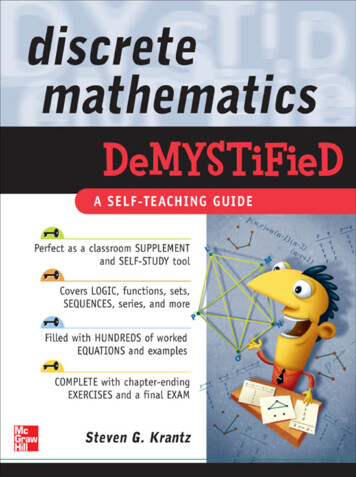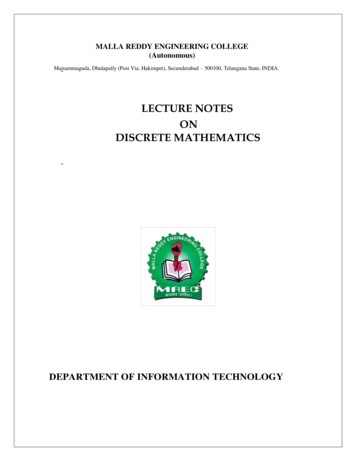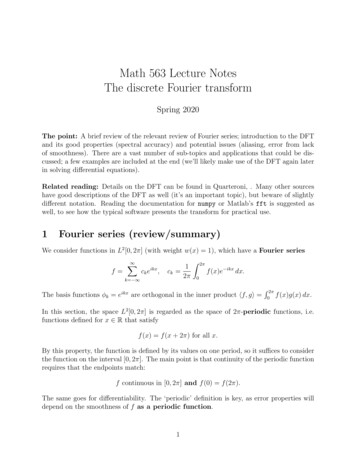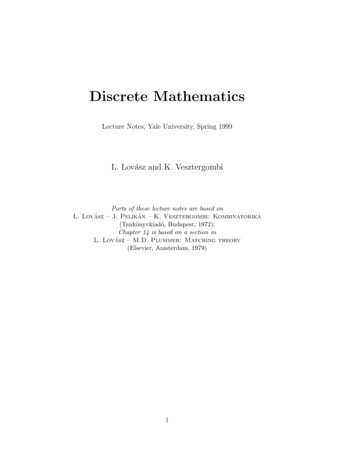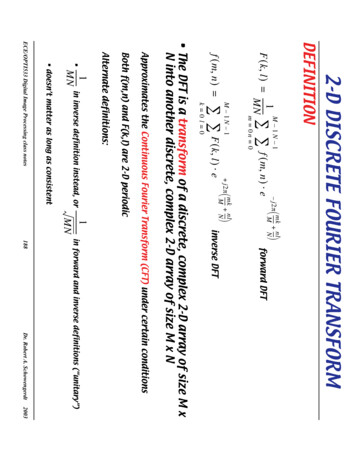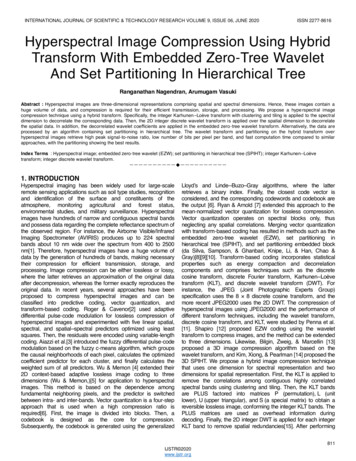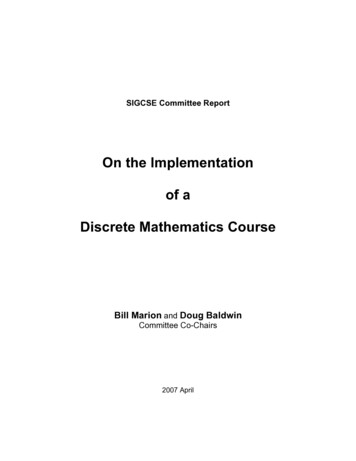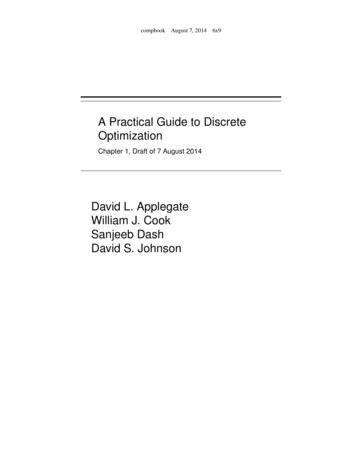
Transcription
compbookAugust 7, 20146x9A Practical Guide to DiscreteOptimizationChapter 1, Draft of 7 August 2014David L. ApplegateWilliam J. CookSanjeeb DashDavid S. Johnson
compbookAugust 7, 20146x9The final test of a theory is its capacity to solve the problems whichoriginated it.George B. Dantzig, 1963.
compbookAugust 7, 20146x9PrefaceA beautiful aspect of discrete optimization is the deep mathematical theory that complements a wide range of important applications. It is the mix of theory and practicethat drives the most important advances in the field. There is, however, no denying theadage that the theory-to-practice road can be both long and difficult. Indeed, understanding an idea in a textbook or on the blackboard is often but the first step towardsthe creation of fast and accurate solution methods suitable for practical computation.In this book we aim to present a guide for students, researchers, and practitioners whomust take the remaining steps. The road may be difficult, but the adoption of fundamental data structures and algorithms, together with carefully-planned computationaltechniques and good computer-coding practices, can shorten the journey. We hope thereader will find, as we do, elegance and depth in the engineering process of transforming theory into tools for attacking optimization problems of great complexity.iii
compbookAugust 7, 20146x9
compbookAugust 7, 20146x9Chapter OneThe SettingI don’t think any of my theoreticalresults have provided as great a thrillas the sight of the numbers pouringout of the computer on the night Heldand I first tested our boundingmethod.Richard Karp, 1985.Discrete optimization is the study of problems that involve the selection of the bestalternative from a field of possibilities. The shortest-path problem asks for the quickestway to travel from one point to another along a network of roads, the traveling salesmanproblem asks for the shortest way to visit a collection of cities, optimal matching problems ask for the best way to pair-up a set of objects, and so on. Discrete-optimizationmodels, such as these, are typically defined on discrete structures, including networks,graphs, and matrices.As a field of mathematics, discrete optimization is both broad and deep, and excellent reference books are available. The main lines of research described in this mathematics literature concern structural theory and the basic solvability of certain classesof models. Discrete optimization is also studied in theoretical computer science, whereresearch focuses on solution algorithms that are provably efficient as problem sizes increase to infinity. In both cases, the motivating interest stems from the computationalside of the subject, namely, the great number of problems of practical and theoreticalimportance that come down to making an optimal selection. This computational sidehas a natural home in the applied field of operations research, where discrete optimization is an important tool in the solution of models arising in industry and commerce.N EEDLE IN THE HAYSTACKAt first glance, discrete optimization, as an applied subject, seems particularly simple:if you have a field of possibilities, then examine each alternative and choose the best.The difficulty comes down to numbers. Paths, traveling salesman tours, matchings, andother basic objects are all far too numerous to consider checking solutions one by one.This numbers argument is easy to see in the case of the traveling salesman problem,or TSP for short. Suppose we need to visit n cities in a tour that starts and ends at thesame city. The length of such a circular tour does not depend on where we begin, sowe may fix any city as the starting point. We then have n 1 choices for the second1
compbookAugust 7, 20146x92CHAPTER 1city, n 2 choices for the third city, and so on. The total number of tours is thus(n 1)! (n 1) (n 2) (n 3) · · · 2 1.For ten cities this is only 362,800 possibilities and it would be easy enough to examinethem all with the help of a computer. Even twenty cities looks solvable by runningthrough all 1.2 1017 candidates, if you have a very fast machine and sufficient patience. But going up to thirty cities gives 8.8 1030 tours, and such a number is wellout of the reach of any available computing platforms. In interpreting such a statement,keep in mind that although computers are fast, they do have limitations. The world’stop-ranked supercomputer in 2011 has a peak performance of 34 1015 operations persecond. So even if it could be arranged so that checking each new tour requires a singleoperation only, we would still need over 700,000 years for the full computation.Now please do not read too much into this numbers game. The 700,000-year computation does not imply that TSPs with thirty cities are unsolvable. Definitely not.Instances of the salesman problem with hundreds or even thousands of cities are solvedroutinely with current methodology. All the numbers game shows is that simple enumeration methods cannot succeed. The haystack is far too large to find the needle bybrute force, even with the help of the fastest computer in the world.I S THE SALESMAN TOUGH ?Among discrete optimization problems, the TSP has a notorious reputation. At a conference several years ago, Sylvia Boyd, a professor at the University of Ottawa, rana contest where fellow mathematicians were asked to find salesman tours through aset of fifty points. The restriction was that contestants could use by-hand calculationsonly. After several days a winner was announced, but the winning tour was in fact nota best-possible solution to the problem. Some of the world’s top experts were unableto solve a small instance of the TSP without the help of their computers and software.We relate the story of Boyd’s contest to emphasize that, although the numbers gamedoes not prove the TSP is actually tough to solve, to date no one has discovered amethod that is both guaranteed to produce optimal tours and is provably efficient in away we describe later in the chapter. This does not contradict our earlier statement thatthe solution of instances with hundreds of cities is routine: we may not have a provablyefficient method for the TSP, but through a sixty-year research effort it is now possibleto solve many typical examples of the problem, including those with a thousand ormore cities. Discrete optimization may be difficult, but a take-no-prisoners approachcan lead to optimal solutions in a surprising number of settings.S HORTEST PATHSIf you have used one of the many Web services for obtaining driving directions, thenyou have witnessed the nearly instantaneous solution of an optimization problem. Theunderlying model in this application is the shortest-path problem. Finding shortestpaths again amounts to locating needles in huge haystacks, but in this case there areeasy-to-apply methods that would allow you, for example, to find an optimal solution
compbookTHE SETTINGAugust 7, 20146x93using by-hand computations on road networks of modest size. The existence of suchtechniques does not, however, explain how a Web service can produce so quickly anoptimal solution over an enormous network of points and roads. Large-scale probleminstances call for sophisticated data structures and algorithms, bringing state-of-the-artcomputer science techniques to deliver on-the-fly solutions.P ERFECT MATCHINGSA perfect matching of an even number of points is a partition of the points into pairs,that is, each point is paired up with exactly one other point. Given as input a costassigned to each pair, the problem is to compute a perfect matching of minimum total cost. Perfect-matching models arise in a number of contexts, such as organizingcell-phone towers into pairs to serve as backups for one another, or pairing up humansubjects in medical tests.In the early 1960s, Jack Edmonds designed an algorithm for computing minimumcost perfect matchings. His method involves deep ideas and it can hardly be calledeasy-to-apply, but it is provably efficient, setting matching problems apart from thoselike the TSP. Edmonds’s method is also practical, although it took a long line of research papers to arrive at an effective computer implementation of his complex algorithm. The work here involved a combination of mathematics, algorithmic theory, datastructures, software engineering, and computer hardware. Quite an effort. Indeed, thecomplexity of solution methods in discrete optimization can sometimes make practicalwork challenging, but the rewards in terms of problem solvability can be great.T HE GOALDifficult, large, and complex. These are the characteristics of computational settings indiscrete optimization. The aim of our book is to take the reader into this arena, covering aspects of the subject that are typically skipped over in standard presentations.The book can be viewed as a how-to guide for practical work, ranging from the solution of models with tough-guy reputations, such as the TSP, through those like theshortest-path problem, where successful application requires the solution of instancesof exceptionally large scale, and the perfect-matching problem, where efficiency canbe gained only through complex methodology. Throughout the book the focus will beon integrating the mathematics of discrete optimization with the technology of moderncomputing platforms.1.1 NEED FOR SPEEDAs a warm up, let’s take a look at finding solutions to instances of the TSP. You mightbe surprised by this choice, since a generally efficient algorithm is not known for theproblem. This is the point, however, allowing us to discuss an implementation of anextremely simple method. The tradeoff is that we must restrict ourselves to tiny test instances. But don’t worry, later in the book we will see implementations of much moresophisticated algorithms, including state-of-the-art attacks on the TSP. And although
compbookAugust 7, 20146x94CHAPTER 1the method we describe now is simple, it will bring up several important general issuesabout speed and the need to avoid repeated computations. Indeed, our discussion follows the very nice TSP article “Faster and faster and faster yet” by Jon Bentley [10],where he writes “And finally, we’ll go hog-wild and see speedups of, well, billions andbillions.”To begin, suppose we have ten cities to visit and we wish to do so using the shortestpossible tour. Even more precisely, suppose we wish to visit the ten cities in the UnitedStates displayed in Figure 1.1. These locations were part of a 33-city TSP contest,7 - Butte8 - Boise4 - Lincoln9 - Reno1 - Erie0 - Chicago3 - Kansas City5 - Wichita2 - Chattanooga6 - AmarilloFigure 1.1: Ten cities in the United States.ran by Procter & Gamble in the 1960s, that included a 10,000 prize for the shortesttour. The city-to-city driving distances displayed in Table 1.1 are taken from the contestrules. In this example, for each pair of cities A and B, the distance to drive from Ato B is the same as the distance to drive from B to A. When the input data satisfythis property, the problem is known as the symmetric TSP. Our implementation takesadvantage of this symmetry, but it is easy to modify the general method to work alsowith asymmetric data.As a preliminary step, we need to decide how to represent a potential solution tothe problem. The simplest choice is to describe a tour by giving the itinerary for thesalesman. For example, starting at Chicago, visit the remaining cities in the order Erie,Chattanooga, Wichita, Amarillo, Reno, Boise, Butte, Lincoln, Kansas City, and backto Chicago. Using the city labels listed in Table 1.1, we can represent the tour as anarray of ten numbers:0125698743A picture of the array is fine for a discussion, but we also need to describe it in a formthat can be manipulated by a computer code. Now this gets into a religious matter.
compbookAugust 7, 20146x95THE SETTING0 Chicago1 Erie2 Chattanooga3 Kansas City4 Lincoln5 Wichita6 Amarillo7 Butte8 Boise9 75150767890131901262 48301320 842 432 0Table 1.1: City to city road distances in miles.In a large group of potential readers, we will no doubt find votes for any number ofprogramming languages to use in our presentation, such as C, C , Java, Python, andMatlab, to name just a few. Each language has its own strengths and weaknesses.Keeping things somewhat old school, we have adopted C throughout the book, for thegood reason that most of the actual computer codes we draw upon for examples arewritten in C. We will, however, attempt to use the language in a vanilla fashion, to keepthings familiar and to allow for easy translation.In the C language, an array of ten integers, called tour, is declared by the statementint tour[N];where N is defined to be the number of cities. The first element of the array is accessedas tour[0], the second element is tour[1], and so on. For example, equipped withan integer-valued function dist(i,j) that returns the travel distance between city iand city j for any pair of cities, the following code will compute the length of a tour.int tour length(){int i, len 0;for (i 1; i N; i ) {len dist(tour[i-1],tour[i]);}return len dist(tour[N-1],tour[0]);}The for-loop runs through the first N-1 legs of the tour, adding the road distance to theinteger variable len; the final addition takes care of the leg back to the starting city.
compbookAugust 7, 20146x96CHAPTER 1Using tour length() we can compute that our sample tour, drawn in Figure 1.2, covers the United States trip in a total of 6,633 miles. This looks pretty good,7890451362Figure 1.2: Tour of length 6,633 miles.but is the tour actually the shortest? One way to check is to simply run through allpossible tours of the ten cities and compute the length of each. An uninteresting, bruteforce approach, but it works fine for tiny instances.E NUMERATING ALL TOURSTo carry out the brute-force search, we need only manipulate the first N-1 elementsof the tour array to generate all possible permutations of the values they store, sincethis corresponds to fixing the final city in the tour. The tool we use in the manipulationis a tour swap() function that exchanges the element stored in position i with theelement stored in position j.void tour swap(int i, int j){int temp;temp tour[i]; tour[i] tour[j]; tour[j] temp;}For example, tour swap(0,8) will exchange the elements stored in positions 0and 8. Now, to generate all permutations of the first N-1 elements, we will one-byone move each of the cities stored in the first N-1 positions to position N-2, andthen generate all permutations of the symbols now in the first N-2 positions. This isaccomplished by calling the following function as permute(N-1).
compbookAugust 7, 20146x9THE SETTING7void permute(int k){int i, len;if (k 1) {len tour length();if (len bestlen) {bestlen len;for (i 0; i N; i ) besttour[i] tour[i];}} else {for (i 0; i k; i ) {tour swap(i,k-1);permute(k-1);tour swap(i,k-1);}}}The argument k indicates that all permutations of the first k elements of tour shouldbe generated. If k is 1, then we have reached our next full permutation of the N citiesand we therefore compare the corresponding tour length with the best value we havefound previously. Whenever we find a new best tour, we record its value in a variablebestlen and record the tour itself in an array besttour.You might want to spend a few minutes convincing yourself that permute()works as claimed. At first glance it appears to be too simple, but the complexity ishidden by the fact that the function calls itself recursively to generate the permutationson one fewer elements. To give you a feeling for the operation of the function, we list inthe three columns of Table 1.2 the order in which permute() runs through all toursfor three, four, and five cities respectively.To test the code yourself, you can refer to the listing given in Appendix A.1, wherewe have added missing pieces to read the distance table, print the shortest tour and itslength, and wrap things in a main() function as required by the C language. Once thecode is compiled, you won’t have to wait long for the result: on a current desktop computer, the 10-city example runs in under 0.01 seconds. The optimal tour is displayed inFigure 1.3. Its length of 6,514 miles improves on our sample tour by traveling directlyfrom city 4 to city 0, picking up city 3 on the lower side of the tour.If the goal is to solve the 10-city instance only, then we should declare victory atthis point. The algorithm is simple, the full code listing has only 72 non-blank lines,and it runs in a hundredth of a second of computing time. A job well done. But whystop at ten cities? With such a fast running time, we ought to be able to push aheadto slightly larger examples. Here we turn to the random Euclidean TSP, where, in ourcase, each city is defined by a point (x, y) with x and y integers chosen at randombetween 0 and 1,000. The travel costs are the straight-line distances between pairs of
compbookAugust 7, 20146x98CHAPTER 11 0 20 1 000111111222222333333444444444444444444444444Table 1.2: Tours generated by permutation function for 3, 4, and 5 cities.7890456132Figure 1.3: Optimal tour, length 6,514 miles.points, rounded to the nearest integer. This test bed has the nice property that we canreadily produce examples as we slowly increase the number of cities n.
compbookAugust 7, 20146x99THE SETTINGSo, how does the brute-force code stack up? Looking at just one sample instancefor each value of n, here are the running times in seconds.CitiesSeconds100.01110.112 131.1 1714215153322At this rate of growth, solving a twenty-city instance would likely take over a billionseconds. This is where we have the need for speed.S AVING TIME AND PRUNING TOURSA first opportunity for a speed upgrade is the current overuse of the tour length()function. Indeed, the time-per-tour can be reduced easily by keeping track of the lengthof the path we build as the permutation is created. To handle this, we include a secondargument, tourlen, in permute() to keep track of the accumulated path length. Inthe recursive call to the function we add to tourlen the distance between cities k 1and k.void permute(int k, int tourlen){int i;if (k 1) {tourlen (dist(tour[0],tour[1]) dist(tour[N-1],tour[0]));if (tourlen bestlen) {bestlen tourlen;for (i 0; i N; i ) besttour[i] tour[i];}} else {for (i 0; i k; i ) {tour swap(i,k-1);permute(k-1, tourlen dist(tour[k-1],tour[k]));tour swap(i,k-1);}}}At each recursive call, the tourlen argument is equal to the length of the path following the cities in order from tour[k] to tour[N-1]. In the k 1 case, twoadditions are used to account for the initial road in the tour and for the return journeyfrom the final city. The modified code reduces the running times to the following, forthe same set of test instances.CitiesSeconds100.006110.04120.613 1411 116151576
compbookAugust 7, 20146x910CHAPTER 1The computation has been cut by half for the 15-city example, but much more importantis that the code is now equipped with a useful bit of information. Namely, we knowthat no matter how we complete the tour[k] to tour[N-1] path into a tour, it willhave length at least the value of tourlen, assuming, quite reasonably, that travel costscannot be negative numbers. This means that if tourlen ever reaches the value ofour best-known tour, then we need not examine the tours that would be obtained bycompleting the current path. Thus, adding the statementif (tourlen bestlen) return;at the start of permute() allows us to prune the search. This one line of code dropsthe running time for the 15-city instance down to 5 seconds.Cities10Seconds 0.003110.01120.0513 140.3 215516 17 1834 22 5619532520646The improvement is so dramatic that we went ahead and pushed on to a 20-city example, solving it in under 11 minutes of computing time. In these results, however, youbegin to see that our use of a single test instance for each value of n is not a good ideain a computational study. Indeed, the running time for 19 cities is much greater thanthe time needed for 20 cities. This is due to the complex operation of the algorithm,where pruning can happen more quickly for some distributions of points than it doesfor others. To be rigorous we would need a statistical analysis of a large number of testinstances for each n, but allow us to continue on with our simple presentation. We willhave a detailed discussion of appropriate test environments in Chapter 14.Continuing with our implementation, the pruning idea looks like a winner, so let’scarry it a bit further. When we cut off the search, we are assuming only that the remaining path through the cities stored in positions 0 through k 1 must have lengthat least zero. This is a simple rule, but it ignores any additional information we mayhave concerning travel costs. An improvement comes from the following observation:to complete a tour, we must select distinct roads entering each of the cities stored intour[k-1], tour[k-2], down to tour[0], as well as a road returning to the final city. We don’t know beforehand which of these roads make up the shortest paththrough the cities, but each selected road must be at least as long as the shortest amongall roads entering the specific city. So here is what we do. Using a third argument,cheapsum, in the function permute(), we keep track of the sum, over all citiesstored in positions 0 through k 1 and the final city, of the shortest roads entering eachcity. The pruning test is then changed to the following line of code.if (tourlen cheapsum bestlen) return;To update cheapsum we compute, at the start of the code, an array cheapest thatstores the length of the shortest road entering each of the n cities in the problem. Theinitial call to permute() sets cheapsum to be the sum of all of the values stored inthe array, and the recursive call becomes
compbookAugust 7, 20146x911THE SETTINGpermute(k-1, tourlen ]]);Thus cheapsum is decremented by the length of the shortest road entering the nextcity to be placed into the tour. A relatively minor change to the code, but with a bigimpact: the running time for the 20-city instance decreases by a factor of 1,000, nowcoming home in ten seconds. Here are the running times obtained for instances up to25 cities.150.1CitiesSeconds160.3170.118 190.2 420521 22350 362324624572259822Compared with our starting code, the total improvement is now up to a factor of onehundred million for the 20-city Euclidean TSP, and more help in on the way.T REES AND TOURSThe use of cheapsum brings in travel costs for completing a path into a tour, butonly in the most elementary way. Indeed, if we put together the roads that determinethe values in the cheapest array, they would typically not look anything like a path.In fact, the roads would likely not even join up into a connected network. Finding ashortest path to link up a subset of cities is similar in difficulty to the TSP itself, butfinding the cheapest way to connect a subset of cities is something that is quite easy todo. We can use this to obtain a better lower bound on the cost to complete a path into atour, and thus a stronger method for pruning our search.A minimal structure for connecting a set of cities is called a spanning tree. Aminimum-cost spanning tree for the 10-city Procter & Gamble instance is displayed inFigure 1.4. It is clearly not a single path through the set of cities, but its length of 4,4977890456132Figure 1.4: Minimum spanning tree, length 4,497 miles.miles is at least as short as any single path, since each such path is itself a spanningtree.Efficient methods for computing minimum spanning trees were discovered in the1920s, and the well-known algorithms of Kruskal and Prim were published in the
compbookAugust 7, 20146x912CHAPTER 11950s. It is the method of Prim that fits best within our TSP application. A fast implementation of his algorithm, suitable for small examples, can be coded in about twentylines of C, but we leave the details until our discussion in Chapter 3. For now, supposewe have a function mst(int d) that returns the length of a minimum spanning treethrough the first d cities stored in the tour array and the final city tour[N-1]. Withthis new weapon, the cheapsum argument and pruning test can be replaced by thestatementif (tourlen mst(k 1) bestlen) return;at the start of the permute() function. This more powerful bound brings the solutiontime for the 20-city instance down to under a second.CitiesSeconds200.6210.8220.7231.524 251.4 10260.627 2817 3529 302 44The improved running times point out that the spanning-tree bound is a valuabletool for pruning the search, so we ought to make good use of it. In this direction, wecan attempt to get a low value for bestlen early in the computation, since this willallow for quicker pruning of our tours. A good place to start is by calling the followingfunction to compute a nearest-neighbor tour.void nntour(){int i, j, best, bestj;for (i 0; i N; i ) tour[i] i;for (i 1; i N; i ) {best MAXCOST;for (j i; j N; j ) {if (dist(tour[i-1],tour[j]) best) {best dist(tour[i-1],tour[j]);bestj j;}}tour swap(i, bestj);}}The algorithm begins at city 0 and at each step adds as the next city the nearest one thathas not yet been visited. At very little computational cost, we can initialize bestlento be the value of the tour we obtain. Doing so gives the following improvements inrunning times for our test instances.CitiesSeconds257260.5271028 297 0.730 3111 1553296933189341168359
compbookAugust 7, 20146x9THE SETTING13Notice that we are now handling examples with n in the mid 30s, thus giving us a shot atsolving the full 33-city Procter & Gamble instance. Indeed, the optimal tour of 10,861miles, displayed in Figure 1.5, is found by the code in 47 seconds. Unfortunately weare fifty years too late to make a claim for the 10,000 prize.Figure 1.5: Optimal tour for 33-city Procter & Gamble contest.B IGGER GUNSThe sequence of improvements we have described have added a total of 35 lines of Cto our original implementation. That leaves a tidy computer code for small instancesof the TSP; a full listing can be found in Appendix A.2. The next two upgrades are abit more heavy duty, each involving around fifty additional lines, but the payoffs aredramatic.First, it makes sense to try to obtain an even better starting value for bestlenby working harder at our preliminary-tour construction. There are many TSP heuristicmethods that could be considered, but we focus on one of the simplest and earliestideas, proposed by Merrill Flood in the mid 1950s. Flood’s method is to take a nearestneighbor tour and repeatedly make improving two-opt moves. A two-opt move is theoperation of removing a pair of roads and reconnecting the resulting two paths. Forexample, the move displayed in Figure 1.6 improves by 301 miles a nearest-neighbortour for the ten-city Procter & Gamble instance. The two-opt algorithm repeatedlymakes improving two-opt moves until a tour is obtained such that no further improvingmoves exist.The results of the two-opt algorithm are usually pretty good for small TSP instances, but to give our code a chance to find a near-optimal initial tour, we imple-
compbookAugust 7, 20146x914CHAPTER 17890456132Figure 1.6: Two-opt move, replacing (6-8, 7-9) by (6-9, 7-8).mented a for-loop to run the algorithm n times, once for each of the nearest-neighbortours obtained by considering each possible city as the starting point.The second improvement adopts an idea of Bentley [10]. If you observe the operation of the TSP enumeration algorithm equipped with the spanning-tree pruning mechanism, then you will notice that the same spanning trees are computed over and overagain. This violates a golden rule of computer implementations. Bentley’s suggestionis to use a data structure called a hash table to store the length of each spanning treewe compute, and then to check the table before each new spanning-tree computationto see if we know already the result. Hash tables are one of the dynamos of efficientcomputer codes in discrete optimization and we discuss their operation in Chapter 2.Together with these two high-powered improvements, we could not resist makingone further minor tweak. With our symmetric data, it does not matter in which directionwe travel around a tour. Thus, our algorithms need only consider those tours suchthat city 0 comes before city 1 as we work our way back from the fixed final citytour[N-1]. To arrange this, we include a havezero argument in the permute()function and set it appropriately when we encounter city 0. This tweak results in aminor speed up only, but for three lines of code is seems worthwhile.Test results for the nearest-neighbor-based code and our three improved codes arereported in Table 1.3, considering random Euclidean instances with up to 45 cities.The codes get faster as we move from Nearest, to Two-Opt, to Hash Table, to ZeroOne, since we incorporate all of the previous upgrades when we add the next idea. Youwould have to get out a calculator to estimate the total speed up we have obtained overour original brute-force code, but solving a 45-city instance in a little over a minutedefinitely qualifies as “billions and billions.”S OME TSP HISTORYThe above computational results put us into the range of some historically importanttest instances of the TSP. Indeed, as the problem first began to circulate in the mathematics community in the 1930s and 1940s, it was sometimes called the “48-statesproblem,” referring to its ins
As a field of mathematics, discrete optimization is both broad and deep, and excel-lent reference books are available. The main lines of research described in this math-ematics literature concern structural theory and the basic solvability of certain classes of models. Discrete optimization is also studied in theoretical computer science, where

